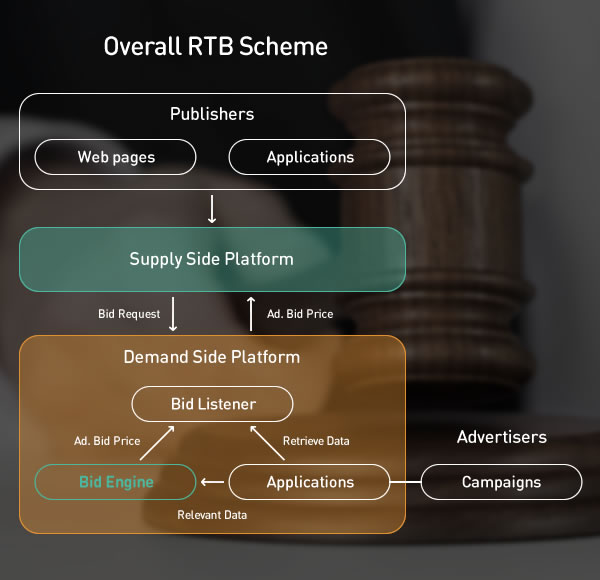Online marketing blog
Read about the latest industry trends and AdCumulus specials.
Real Time Bidding – present and future
By on 22. April 2015.

Media buying does not imply a lot of productive and interesting work. It’s also not a particularly cheap affair, considering that a single advertiser wants ads on several dozens of pages and applications owned by different publishers. However, this is where Real Time Bidding really excels.
The solution to the problem you didn’t know you had
It is not very compelling for the advertiser to go directly to the publisher and negotiate the price for several thousand impressions, no matter what kind of impressions are at stake or what types of mobile users are reachable.
Networks as aggregators seem to accelerate the process of media buying, but not to the extent that brings advertisers to their knees, praising the precious time and possibilities they bring forth.
Although this model of operation still works and will surely work in the future, additional problems arise – what about the inventory that the publisher isn’t able to sell? (Again, Real Time Bidding offers a solution).
Numbers state that unsold inventory amounts to 60%, and the remaining 40% is often sold under price. On the other hand, advertisers lose money due to purchased bulk impressions packaged into a black box, which can contain those that the advertiser doesn’t really need.
This can actually create quite a loss, so the real question is: can this be remedied in any way (and can you already guess the answer)?
Know your history to excel in future
Thanks to some intelligent people from the past, today’s merchants sit and wait in one place, whether it’s the market or a mall. It is very simple to go to one such place with a multitude of sellers and choose a product that suits us best with its properties and prices.
It is convenient that the basic principles of such trade are mimicked centuries later in something we today call Real Time Bidding, or RTB in short.
Although it is a grand-grandson of the purchase of greens on the market, it is a bit harder to explain. Probably because it is not an “everyday term”. It is used by a small group of people and connected to a specific niche.
But trust me, it is actually very simple. RTB refers to the selling and buying of online impressions apiece in real time.
The Process
Publishers sell impressions, huddled under the umbrella of SSP (Supply Side Platform).
It can be understood as a sort of a go-between, a cloud application that brings together several mobile applications and web pages with the goal to sell impressions at the best price, not smaller than the one defined by the publisher.
On the other hand, buyers, or advertisers, also use a go-between: a cloud application called DSP (Demand Side Platform).
DSP brings together advertisers with the goal to find media (impressions) and, indirectly, the end user that best fits desired criteria (targeting) to maximize the effectiveness of each ad.
Every advertiser sets the maximal price he is willing to pay for a single impression. Every DSP can be connected with several SSPs and vice versa, and the means of their communication is a unified protocol called OpenRTB.
Best bet takes it all
The entire setup is rather simple.
The end user visits a certain web page that has been registered with a certain SSP. As he or she opens the web page, a special request arrives to the SSP from the page, who then shouts out to all connected DSPs “I have an impression for sale!”
The SSP also declares all that he knows about the end user, like his device (mobile or desktop), location, etc.
Finally, the SSP also mentions the lowest price at which he is willing to sell the impression.
Every DSP that hears the SSP shouting quickly, taking into consideration a plethora of different parameters, uses an algorithm to calculate how much is said impression worth to an advertiser, or better, which price he will offer for it.
DSP then sends the price to the SSP. Once the SSP has collected several offers, he takes the best one, namely the one with the highest price, and names it the winner!
The victorious DSP gets his ad displayed to the aforementioned end user that opened the web page in the first place.
The entire process is executed very quickly and the end user doesn’t notice any delay, nor is he aware that so much communication and calculation happens in the background.
This is why this supply and demand principle holds the epithet “Real Time”.
Once you go RTB…
To paraphrase the popular TV show, one could say that Real Time Bidding is the “new black” of advertising.
It is hard to deny that impression trade holds a major role today and will continue to do so in times to come. Especially if we take into consideration the ease with which RTB makes decisions in real time, finds pairs of optimal buyers and sellers, and generally, automates and optimizes the process.
Granted, there is place for improvement. Advertising industry needs to educate itself on this business model. Popularization of RTB will gather an even larger number of publishers, which will then create a larger spectrum of impressions available for advertisers to buy.
On the other hand, the increase in the number of advertisers will enable publishers to reach desired prices more easily and increase the number of buyers. Simply said, this potent market must continue its growth.
Algorithms doing the work for you
The price setting at the DSP, which we mentioned earlier, is determined by algorithms. Their mission is to set the lowest price possible with the largest chances to win the auction.
The obvious goal for each advertiser is to reach as many quality impressions with as little money spent as possible. This is all finely seasoned with the time limitation that forces the advertisers to end the auction on time.
Rarely will the advertiser think about the technical realization of algorithms while making a deal with the DSP, but it might not be a bad idea, since every algorithm has its strong and weak points that the advertiser can exploit.
With further advance of this type of market, Real Time Bidding will surely progress as well – optimization will be more pronounced and technical performance will become one of the main arguments when choosing a DSP connected to SSPs.
Is Real Time Bidding the future?
RTB presents the natural progression in display advertising. It eliminates unnecessary interference of the human factor and saves time, money, reduces chances of errors and generally improves advertising.
Even though it is still a relatively new trend, it won’t be long until RTB exits the uncomfortable puberty phase, polished and nearly perfect. Old methods will be one step closer to retirement and the whole world will see who’s the new boss.
How about you? Want to find out how RTB can improve your business?
Contact us and enhance your advertising right away!






Comments